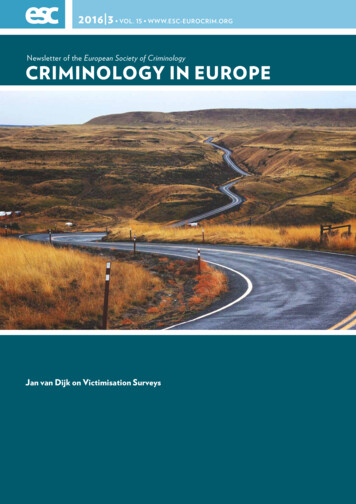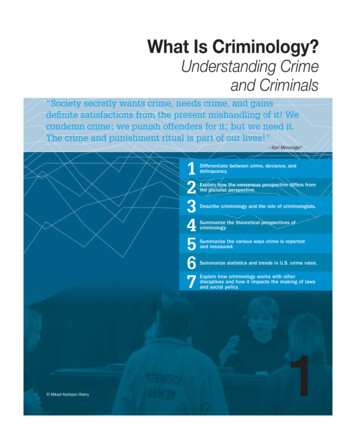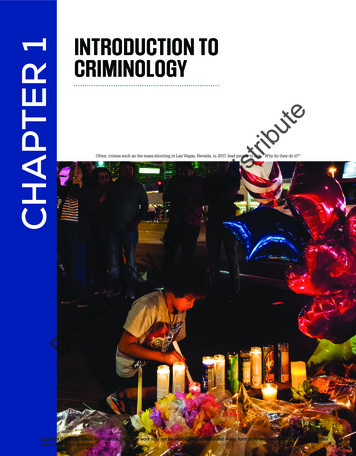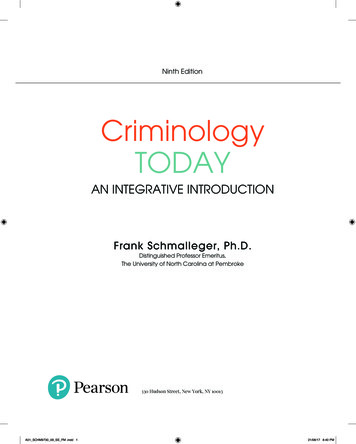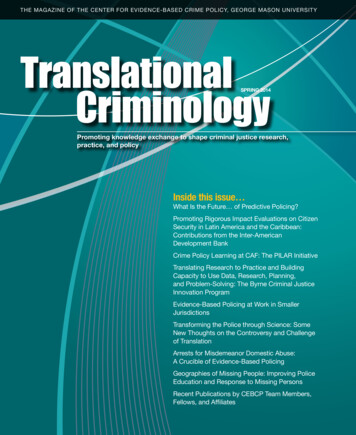
Transcription
The Magazine of the Center for Evidence-Based Crime Policy, George Mason UniversityTranslationalCriminologySPRING 2014Promoting knowledge exchange to shape criminal justice research,practice, and policyInside this issue What Is the Future of Predictive Policing?Promoting Rigorous Impact Evaluations on CitizenSecurity in Latin America and the Caribbean:Contributions from the Inter-AmericanDevelopment BankCrime Policy Learning at CAF: The PILAR InitiativeTranslating Research to Practice and BuildingCapacity to Use Data, Research, Planning,and Problem-Solving: The Byrne Criminal JusticeInnovation ProgramEvidence-Based Policing at Work in SmallerJurisdictionsTransforming the Police through Science: SomeNew Thoughts on the Controversy and Challengeof TranslationArrests for Misdemeanor Domestic Abuse:A Crucible of Evidence-Based PolicingGeographies of Missing People: Improving PoliceEducation and Response to Missing PersonsRecent Publications by CEBCP Team Members,Fellows, and Affiliates
CEBCP Mission StatementThe Center for Evidence-Based Crime Policy (CEBCP), housed within the Department of Criminology, Law and Society at GeorgeMason University, seeks to make scientific research a key component in decisions about crime and justice policies by advancingrigorous studies in criminal justice and criminology through research–practice collaborations and proactively serving as aninformational link to practitioners and the policy community. Translational Criminology advances this mission by illustratingexamples of how research is converted into criminal justice practice.StaffExecutive Director: David WeisburdDirector: Cynthia LumDeputy Director: Charlotte GillFellows: James Bueermann, Christopher Koper,Brian Lawton, Stephen Mastrofski, Linda Merola,Anthony Petrosino, Laurie Robinson, James Willis,Dave WilsonResearch Assistants: Breanne Cave, Julie Grieco, StephenHappeny, Kirsten Hutzell, Matthew Nelson, JordanNichols, Sang Jun Park, Zoe Vitter, Heather Vovak,Alese WooditchExecutive Assistant and Office Manager: Naida KuruvillaAffiliated Scholars: Martin Andresen (Simon FraserUniversity), Elizabeth Groff (Temple University), JulieHibdon (Southern Illinois University), Joshua Hinkle(Georgia State University), Travis Taniguchi (The PoliceFoundation), Cody Telep (Arizona State University),Sue-Ming Yang (National Chung Cheng University,Taiwan)Research ProgramsCrime and PlaceEvidence-Based PolicingSystematic ReviewsCriminal Justice PolicyAdvisory BoardChair: Peter Neyroud, Cambridge UniversityRobert Boruch, University of PennsylvaniaGerben Bruinsma, Netherlands Institute for the Studyof Crime and Law EnforcementJames Bueermann, The Police FoundationCathy Lanier, Metropolitan D.C. Police Department,Washington, D.C.Jerry Lee, Jerry Lee Center of Criminology,University of PennsylvaniaFriedrich Lösel, Emeritus, Cambridge UniversityDaniel Nagin, Carnegie Mellon UniversityCarol Petrie, DSG Inc.Lawrence Sherman, University of Marylandand Cambridge UniversityDarrel Stephens, Major City Chiefs AssociationChristine Visher, University of DelawareHubert Williams (retired), The Police FoundationTranslationalCriminologyspring 2014Promoting knowledge exchange to shape criminal justice research,practice, and policyFrom the Directors . . . . . . . . . . . . . . . . . . . . . . . . . . . . . . . . . . . . . . . . . . . 1What Is the Future of Predictive Policing? . . . . . . . . . . . . . . . . . . . . . . . 4Promoting Rigorous Impact Evaluations on Citizen Securityin Latin America and the Caribbean: Contributions from theInter-American Development Bank . . . . . . . . . . . . . . . . . . . . . . . . . . . . . . 6Crime Policy Learning at CAF: The PILAR Initiative . . . . . . . . . . . . . . . . . . 7Translating Research to Practice and Building Capacityto Use Data, Research, Planning, and Problem-Solving:The Byrne Criminal Justice Innovation Program . . . . . . . . . . . . . . . . . . . . 9Evidence-Based Policing at Work in Smaller Jurisdictions . . . . . . . . . . . 14Transforming the Police through Science: Some New Thoughtson the Controversy and Challenge of Translation . . . . . . . . . . . . . . . . . . 16Arrests for Misdemeanor Domestic Abuse:A Crucible of Evidence-Based Policing . . . . . . . . . . . . . . . . . . . . . . . . . . 20Geographies of Missing People: Improving Police Educationand Response to Missing Persons . . . . . . . . . . . . . . . . . . . . . . . . . . . . . . 22Recent Publications by CEBCP Team Members,Fellows, and Affiliates . . . . . . . . . . . . . . . . . . . . . . . . . . . . . . . . . . . . . . . . 28Contact UsCenter for Evidence-Based Crime PolicyGeorge Mason UniversityResearch Hall, Room 310-3184400 University Drive, MS 6D12Fairfax, VA 22030George Mason University photos by Alexis Glennand Evan CantwellWhere Innovation Is TraditionWebsite: www.cebcp.orgE-mail: cebcp@gmu.eduTwitter: @cebcpYouTube: clsmason
F rom t h e D irec t o rsWelcome to the Center for Evidence-Based Crime Policy(CEBCP), housed in the Department of Criminology,Law and Society at George Mason University. TheCEBCP has become one of the most active centers at Mason,supporting research, policy outreach, teaching, and graduate studenttraining since 2008. We are proud to present you with the spring2014 issue of our biannual magazine Translational Criminology. Themagazine showcases examples of the core aspirations of the CEBCP:to advance the development of rigorous and practice-oriented scienceand to work with our partners to think carefully about the mechanicsof knowledge exchange and research translation.Building bridges between science and practice is a difficult andcomplex venture that is rarely accomplished simply by doing researchor applying findings. Thus, in this issue, our contributors focus on anumber of challenging issues in evidence-based crime policy. JerryRatcliffe from Temple University deliberates predictive policing andits future in the context of reforms and needs of law enforcementagencies. Two of our Latin American partners—Gustavo Beliz(Inter-American Development Bank) and Daniel Ortega (Development Bank of Latin America)—discuss their organizations’ experiences in implementing more scientific approaches in decisionsregarding economic and social development. Peter Neyroud andDavid Weisburd explore critiques of their previous discussions ofpolice “ownership” of science and advance the debate. Capt. TimHegarty from the Riley County (Kansas) Police Department partnerswith Sue Williams, professor at Kansas State University to showcasehow experiments and hot spots policing can be accomplished insmaller jurisdictions. Our partners from the Scottish Institute ofPolicing Research—Olivia Stevenson (University of Glasgow), PennyWoolnough (forensic psychologist at Police Scotland), and HesterParr (University of Glasgow)—write about the geography of missingpersons and using research to help develop policy in this area.Elizabeth “Betsi” Griffith tells readers about the new Bureau ofJustice Assistance Byrne Criminal Justice Innovation Initiative, whichlinks evidence-based approaches with community justice needs.Finally, Lawrence Sherman and Chief Ed Flynn present the resultsand implications of their longitudinal follow-up of the MilwaukeeDomestic Violence Experiment. Each of these pieces sheds lighton a number of issues that are in need of more understanding andknowledge.This year, we had and will have a number of exciting events foryou to attend. On January 24, 175 first- and second-line policesupervisors from more than 50 agencies attended the first trainingof its kind at Mason, focusing on evidence-based policing at the linesupervisory level. This group of justice practitioners is one of themost important to translating research in everyday policing, and wewere proud to partner with the Center for Justice Leadership andManagement at Mason, the U.S. Police Foundation, the NorthernVirginia Criminal JusticeAcademy, and the Bureauof Justice Assistance to puton this excellent event.On April 1, we will holdour seventh congressionalbriefing on the topic ofPretrial Justice: ResearchEvidence and Future Prospects, in collaboration with colleagues atthe Pretrial Justice Institute. This event will be held in the GoldRoom of the House of Representatives’ Rayburn Building at the U.S.Capitol. Finally, on June 23–24, we will hold the CEBCP annualsymposium, in partnership with the Inter-American DevelopmentBank, with panels exploring the many research projects in which theCEBCP and our partners are engaged. Topics will include pressingcriminal justice policy concerns including community crimeprevention, police technology, experimental research in crime policy,firearms violence, and criminal justice in Latin America. Thesymposium also is where we will present the prestigious 2014Evidence-Based Policing Hall of Fame inductees, as well as theCEBCP’s Distinguished Achievement Award, both celebrating theimplementation of research in practice. We hope you will join usfor these important events (more information can be found atwww.cebcp.org).Finally, in this issue we celebrate the people who make the CEBCPwhat it is today. One of our most important assets is our collegialityand team spirit, which helps to make all of the events, activities, andTranslational Criminology happen. View our entire team, includingour executive staff, fellows, graduate research assistants, affiliatescholars, and advisory board members on page 25. You can also getto know CEBCP’s work ethic by reading our Code of Excellence,which our team developed together to foster our professionalworking environment. As we turn the corner to our seventh year,we look forward to further growth and success in the years ahead.David Weisburd, Executive DirectorCynthia Lum, DirectorCenter for Evidence-Based Crime PolicyGeorge Mason UniversityIf you have an idea for a future article for TranslationalCriminology that illustrates research in practice, pleasee-mail the directors at cebcp@gmu.edu.Spring 2014 Translational Criminology1
Research The criminology of placesJuvenile crime hot spotsAirport securityPolice discretion and deterrenceLaw enforcement technologyReentry servicesSystematic reviewsEvaluation of crime preventioninterventions Firearms and crimePartnerships Local, regional, state, and national governmentagencies Nonprofit research groups and foundations Law enforcement agencies in the United Statesand abroad Researchers from universities around the world Community groups and outreach workers Criminal justice national associationsThe Center for Evidence-Based Crime PolicyTranslationOutreach Evidence-Based Policing MatrixMatrix Demonstration ProjectTraining and Technical AssistanceLicense Plate Reader web portalEvidence assessments (TSA, FPS, Seattle)Systematic reviewsEducation Graduate and undergraduate student mentoring Student-led research groups and projects Professional workshops for justice practitioners,researchers, and policy makers Presentations, keynotes, and webinars Training and technical assistance SymposiaCongressional briefingsResearch one-pagersTranslational Criminology magazineTranslational Criminology SpringerBriefsCEBCP Video LibraryEvidence-Based Policing Hall of FameDistinguished Achievement Awardin Evidence-Based Crime PolicyAdvisory boards and consultationCrime and Place Working Groupcebcp.org2www.cebcp.org
The Center for Evidence-Based Crime Policy and the Inter-AmericanDevelopment Bank presentThe 2014 CEBCP-IDB Symposiumon Evidence-Based Crime PolicyWe welcome everyone to our annual symposium on Evidence-Based Crime Policy, June 23–24at George Mason University’s Arlington Campus .Panels will address research and policy on police technology, communities and crime, firearmsand violence, crime analysis, development projects in Latin America and the Caribbean, and scienceand public policy.Special events will include:· A keynote address on June 23 by Daniel Ortega of the Development Bank of Latin America (CAF)· A special recognition of, and keynote address by, Daniel Nagin, 2014 Stockholm Prize Winner on June 24· The inductions of the 2014 Evidence-Based Policing Hall of Fame Members· The presentation of the 2014 Distinguished Achievement Award in Evidence-Based Crime PolicyFor more information, visit cebcp.org.with support from the Inter-American Development Bank,and George Mason University’s College of Humanities andSocial Sciences, Provost’s Office, and Office of University Life.Spring 2014 Translational Criminology3
What Is the Future of Predictive Policing?BY JERRY RATCLIFFEJerry Ratcliffe is a professor and the chair of the Department of CriminalJustice at Temple University where he also directs the Center for Securityand Crime Science. He is a member of the CEBCP’s Crime and PlaceWorking Group.Law enforcement’s current zeitgeist is predictive policing. Policechiefs roam training conferences for any insight into this nextcareer-enhancing strategy, mayoral candidates promise it willsave the city, and software companies insert the phrase into everyadvertising brochure for fear of not being on the bandwagon. Sowhat is it, and what is it supposed to do? This article presents a briefdiscussion of the term, a synopsis of the necessary conditions, and acautionary warning.What Is Predictive Policing?There is no accepted definition of predictive policing. The onlyconstant appears to be an obligatory reference to having no relationship to the movie Minority Report (though perhaps like most TomCruise movies, it promises more than it can deliver?). A recentpublication defined it as “the application of analytical techniques—particularly quantitative techniques—to identify likely targets forpolice intervention and prevent crime or solve past crimes by makingstatistical predictions.”1 But many will find this definition tooexpansive given that it could incorporate forensic science, psychological profiling, and support to reactive investigations.In general, predictive policing in the context of place is the use ofhistorical data to create a spatiotemporal forecast of areas of criminality or crime hot spots that will be the basis for police resourceallocation decisions with the expectation that having officers at theproposed place and time will deter or detect criminal activity. I writeforecast because a prediction is definitive and specific, whereas aforecast is more probabilistic. With this definition, it could be arguedthat some police departments have been practicing predictivepolicing for a while now. For years, many law enforcement agencieshave held Compstat-type meetings and are capable of creating crime(kernel density) surface maps that determine patrol areas.But if that reassurance is not enough to satisfy your mayor or sheriff,what is necessary to get up and running with predictive policing?What Conditions Are Necessary?After discovering that near-repeat chains of Philadelphia streetrobberies were not only rare, but also had a very short half-life, CoryHaberman and I cautioned that anypolice response system would requirefour significant requirements: anadequate surveillance mechanism, aresponsive and capable analyticalregime, a viable decision-makingframework, and significant operationalflexibility.2 It is worth noting that useof computer software is not discussedbecause it is entirely possible that underthe right circumstances a well-trainedJerry Ratcliffecrime analyst could perform the firsttwo items without the aid of software. Expanding on the above list alittle, numerous challenges with regard to predictive policing arepresent: Access to data. Do you require access to real-time crime data? Arecrime and other required non-crime data sets reliable, geocoded,and fit for purpose? How reliable? Who is responsible for maintenance? Are ongoing costs considered? Predictive algorithm. Is the software easy to use? Is it time-consuming and analytically intensive? Does it require data sets thatneed costly maintenance and conversion? Are the limitations of thepredictions widely understood and accepted? Are the predictionsmade in a format useable to police? How long is the forecastviable? Decision-making system. Is there a viable decision-makingsystem that is capable—and willing—to use predictions todetermine resource allocation decisions? Is it responsive enough toemploy predictions effectively? Do predictions arrive in a time andformat compatible with decision making? Is there managementand frontline buy-in? Appropriate and effective tactics. Are swift resource deploymentdecisions actioned? Are the right tactics applied to the crimeproblem? Are officers enthusiastic about computerized crimeforecasts? Crime reduction. Is the process evaluated for accuracy andeffectiveness? Does your agency appreciate the difference betweenprediction accuracy and crime reduction effectiveness? Is predictivepolicing cost effective compared with other strategies? Are possiblenegative consequences discussed and monitored? Are lessonslearned that could influence and drive longer-term solutions?1 Perry, W. L., B. McInnis, C. C. Price, S. C. Smith, & J. S. Hollywood. (2013). Predictive Policing: The Role of Crime Forecasting in Law EnforcementOperations. Washington, DC: Rand Corporation, xiii.2 Haberman, C. P., & J. H. Ratcliffe. (2012). The Predictive Policing Challenges of Near Repeat Armed Street Robberies. Policing: A Journal of Policy andPractice 6(2), 151-166.4www.cebcp.org
Types of Predictive ModelsCurrently, most predictive policing software programs are largelyfixed in terms of the output prediction format and spatiotemporalunit of analysis. They will mostly provide a forecast of target areasfor a predetermined range of fixed spatial units and temporal units.An improvement would be adaptive algorithms that range acrossdifferent spatial and temporal units, within the same forecast,allowing police to select a strategy appropriate to the dimensionsof the crime problem (as optimized by the software procedure).Another possibility is the use of responsive systems. Progressivedepartments could predetermine their spatiotemporal responseability and allow the algorithm to identify optimal crime patterns.For example, an urban department may seek predictions for violentcrime at the census block group level that would be amenable to footpatrol, while another might wish to optimize the boundaries ofvehicle patrol areas or a problem-oriented policing team zone.These typologies emphasize different aspects of predictive policing.Fixed systems seek to maximize prediction efficiency but requirepolice to limit their strategy to suit the prediction output format.Adaptive systems seek to maximize prediction accuracy but requirethe police department to craft a tailored response. Responsive systemswould maximize policing operability but would likely do so at thecost of predictive accuracy. An appropriate prediction for a tacticalpatrol unit should differ significantly from that for a problem-oriented policing team looking to set annual priorities, so in realitythere is likely no one right way to generate crime forecasts. Thepredictive methodology cannot be decoupled from the policingframework because predictive policing is an applied science.How Do We Determine Accurate and Effective?If we are only focused on the predictive algorithm, then it is easy toassume this question is empirical. For example, the predictionaccuracy index3 is a handy ratio measure of the number of predictedcrime events and the prediction area; however, difficulties arise whenalgorithms are structured probabilistically and map an entire studyarea with values ranging from hotter to colder. Any cut-off point can,in the absence of a scientific rationale, appear arbitrary and subjective.Furthermore, scientific notions of accuracy, within the policingcontext, are complicated by applicability. Seventy percent accuratephoto by the Philadelphia Police DepartmentThese are not ivory tower, pedantic trifles, but rather key questionsfundamental to the maximization of community safety, the effectiveuse of public funds, and the success of predictive policing, howeverdefined. There is rarely discussion of the strategy associated withpredictive policing, with typically a blanket assumption of saturationpatrol by uniform officers. Too few proponents appear to discussresource implications, tactics, evaluation, or alternative responses(such as problem-oriented policing or intelligence-led policing). Thepolicing context is therefore pivotal to the type of predictive model.and actionable may be preferable to 80 percent accurate but beyondthe managerial or resource capacities of a police department. Buteven 80 percent accurate suggests a 20 percent failure rate. If asoftware company makes over-enthusiastic accuracy and precisionclaims, street police officers will lose enthusiasm rapidly if they areregularly sent to areas with no apparent activity. Analogous tostatistical false positives, I call this phenomenon a false expectationproblem.The efficacy of crime predictions are conflated with the policingresponse. If a police department adopts a predictive policing strategybut crime does not drop, is this a failure of the predictive algorithm,the choice of response tactic, or the implementation of the response?If this field is to move forward with a sound scientific foundation, itwill need strong experimental conditions to demonstrate its value.Forests or Trees?When police departments moved from pin maps of individualincidents and began exploring chronic crime hot spots, they movedfrom mapping trees to finally seeing the forest. This provided afoundation for examining enduring crime problems that had plaguedcommunities for months and years. Finally being able to see theforest’s scale created space for developing less reactive strategies, suchas problem-oriented policing and third-party policing, both evidence-based successful crime reduction approaches to crime “forests.”A reversal now appears under way, but I would urge caution.Predictive policing may be the zeitgeist, but it is still in its infancy.The predictive side has not yet matured as a science and beensubjected to sufficient replication and critique to be reliably trusted,and discussion of the policing strategy component is to date largelynonexistent beyond directed patrol. In our fascination to predict anindividual tree, let’s not forget that it is usually part of a much moreimportant forest of crime.3 Chainey, S., L. Tompson, & S. Uhlig. (2008). The Utility of Hotspot Mapping for Predicting Spatial Patterns of Crime. Security Journal 21(1-2), 4-28.Spring 2014 Translational Criminology5
Efforts in Latin America and the Caribbean reflect the growing interest in evidence-based approaches in encouraginggood governance and promoting development. Here, our colleagues from the Inter-American Development Bank(IDB) and the Development Bank of Latin America (CAF) discuss their efforts to promote science in publicpolicy. The Inter-American Development Bank will be partnering with the Center for Evidence-Based Crime Policy toput on its next annual symposium on June 23–24, 2014.Promoting Rigorous Impact Evaluations on CitizenSecurity in Latin America and the CaribbeanContributions from the Inter-American Development BankBY GUSTAVO BELIZGustavo Beliz is a lead specialist at the Inter-American DevelopmentBank and works on issues related to citizen security.Latin America and the Caribbean (herein, “the region”) showcrime rates that are among the highest in the world.1 Theseindicators put economic development and democratizationat risk because they affect the efficiency of public spending andinvestment, citizen welfare, and the social capital and credibility ofinstitutions. In view of this situation, these countries have decidedto allocate more financial and human resources for citizen securitythrough public policies to prevent social and situational crime andviolence, and to police judicial and rehabilitation reforms.But, when it comes to impactevaluation of these programs,countries in the region—whencompared with the United Statesor European states—are behind inboth development and rigor. Oneof the reasons acknowledged for this situation is the high cost thatrigorous evaluations incur, especially when public surveys and otherfollow-up work must be conducted. Moreover, the frequent contextsof fiscal restraints often demand new budget allocations because ofcost considerations. However, challenges in the data collection occurbecause the survey topics are not easy to quantify, and there aredifficulties in the selection of the control and treatment groups—veryoften associated to ethical dilemmas. Furthermore, authorities areapprehensive about what evaluations might reveal.Yet, the region has recently begun to move forward in developingmore rigorous evaluations of citizen security programs, a strongGustavo Belizindicator of advanced development.Increasingly, government administrations are becoming more aware of theimportance of carrying out rigorousresearch, which facilitates greatcollection of systematized data, as wellas finding evidence in the areas of theefficiency and effectiveness of policiesand programs. Also, this informationhelps analyze whether those policies andprograms have been successful andwhether they must be continued,redesigned, or concluded.Indeed, for example, it is worth pointing out a scientific evaluationthat studied the impact of electronic monitoring on levels ofrecidivism in Argentina. The study focused on the arrest rates of twogroups: those individuals who were released from prison and thosewho were also released but carried electronic monitors. To analyzethese effects and ensure the random allocation of groups, the authorsof this study capitalized on the fact that detainees in Argentina arenormally allocated randomly to different courts. The findings showthat the electronic monitoring had a major impact on the recidivismreduction: it halved recidivism rates compared with those releasedfrom prison without monitoring.2The Inter-American Development Bank (IDB) has supported theefforts of these countries by requiring stricter evaluations of its loanprograms, including, for example, the Regional System of ImpactEvaluation on Citizen Security Public Policies in Latin America1 A recent United Nations Office of Drugs and Crime report (2011) reported the region had an average homicide rate of 23.8 homicides per 100,000inhabitants.2 Di Tella, R., and E. Schargrodsky. (2013). Criminal Recidivism after Prison and Electronic Monitoring. Journal of Political Economy 121(1), 28-73.6www.cebcp.org
initiative. The program aims to create a regional network that willsystematically promote the execution of high-quality impactevaluations of citizen security programs.3 The main components ofthe program are the generation of common technical skills, thedesign and execution of impact evaluations in the region, and theestablishment of a network in the area. The program is in fullexecution, beginning with seven impact evaluations of interventionsof different cities and countries.4The IDB also recently directed major efforts in measuring the costcaused by crime and violence. The aim is to consistently improve thequality of the data and related infrastructure needed for both thedesign of policies and citizen security programs, as well as thedecision-making process in the budget area. This is especiallyimportant for countries debating public policies. Through theseefforts, the IDB hopes to increase the value that systematic knowledge collection and robust and in-depth analysis have in decisionsconcerning tangible and intangible crime and violence cost. Thestudies engaged by the IDB show the estimation of intangible cost ofviolence against women, the economic consequences of drug-trafficking violence in Mexico, the crime impact on the cost of renting inBrazil, and violence in Uruguay, among others.5 For example, thislast study shows that the cost of crime against property and peoplewas above US 1.2 billion in 2010 in Uruguay, equivalent to 3.1percent of the GDP. Crimes against property are the ones thataccount for a higher cost, and only those costs associated with thevalue of the stolen property totaled US 158 million.More and more development banks and other internationalorganizations are improving social policy not only by fundingprograms, but, more importantly, by assessing the programs theyfund. Such efforts create greater accountability in spending andgovernance, and build important foundations for economic andsocial development.For more information on the Inter-American Development Bank’sefforts, visit www.iadb.org/security.3 More information on this program is located at www.seguridadyevaluacion.org.4 Program Centros de Atención Movil a Drogadependientes – CAMAD (Medical Care Centers to Dependent Drug Users), Bogotá (Colombia); Program SistemaTáctico de Análisis Delictual (Tactical System of Crime Analysis, Chile; Program Sistema de Alarmas Comunitarias para la Provincia (Community AlarmSystem for the Province), Córdoba, Argentina; Program Municipios Más Seguro” (Safer Municipalities), Honduras; Program Gestión Integrada Local para laSeguridad Ciudadana (Local Public Safety Integrated Management Program), Uruguay; Program Casas de Justicia (Houses of Justice), Costa Rica; andProgram Granjas Penitenciarias (Penitentiary Farms), El Salvador. See more at www.seguridadyevaluacion.org.5 See blogs.iadb.org/desarrolloefectivo atin-america-and-the-caribbean/Crime Policy Learning at CAFThe PILAR InitiativeBY DANIEL E. ORTEGADaniel E. Ortega is the impact evaluation coordinator at CAF, Development Bank of Latin America. In this article, he writes about thechallenges of science in public policy and governance in the developingworld.Every government is constantly making decisions on a grand ora small scale. W
Virginia Criminal Justice Academy, and the Bureau of Justice Assistance to put on this excellent event. On April 1, we will hold our seventh congressional briefing on the topic of Pretrial Justice: Research Evidence and Future Prospects, in collaboration with colleagues at the Pretrial Justice Institute. This event will be held in the Gold

